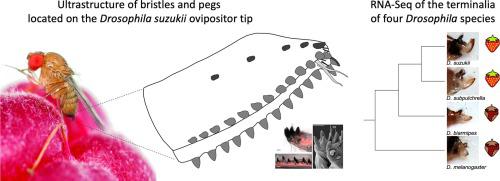Journal of Insect Physiology ( IF 2.2 ) Pub Date : 2020-07-08 , DOI: 10.1016/j.jinsphys.2020.104088 Cristina Maria Crava 1 , Damiano Zanini 2 , Simone Amati 3 , Giorgia Sollai 4 , Roberto Crnjar 4 , Marco Paoli 5 , Marco Valerio Rossi-Stacconi 3 , Omar Rota-Stabelli 3 , Gabriella Tait 3 , Albrecht Haase 5 , Roberto Romani 6 , Gianfranco Anfora 7

|
Drosophila suzukii is an invasive pest that prefers to lay eggs in ripening fruits, whereas most closely related Drosophila species exclusively use rotten fruit as oviposition site. This behaviour is allowed by an enlarged and serrated ovipositor that can pierce intact fruit skin, and by multiple contact sensory systems (mechanosensation and taste) that detect the optimal egg-laying substrates. Here, we tested the hypothesis that bristles present in the D. suzukii ovipositor tip contribute to these sensory modalities. Analysis of the bristle ultrastructure revealed that four different types of cuticular elements (conical pegs type 1 and 2, chaetic and trichoid sensilla) are present on the tip of each ovipositor plate. All of them have a poreless shaft and are innervated at their base by a single neuron that ends in a distal tubular body, thus resembling mechanosensitive structures. Fluorescent labelling in D. suzukii and D. melanogaster revealed that pegs located on the ventral side of the ovipositor tip are innervated by a single neuron in both species. RNA-sequencing profiled gene expression, notably sensory receptor genes of the terminalia of D. suzukii and of three other Drosophila species with changes in their ovipositor structure (from serrated to blunt ovipositor: Drosophila subpulchrella, Drosophila biarmipes and D. melanogaster). Our results revealed few species-specific transcripts and an overlapping expression of candidate mechanosensitive genes as well as the presence of some chemoreceptor transcripts. These experimental evidences suggest a mechanosensitive function for the D. suzukii ovipositor, which might be crucial across Drosophila species independently from ovipositor shape.
中文翻译:

在果蝇铃木产卵器中机械转导的结构和转录证据。
铃木果蝇(Drosophila suzukii)是一种入侵性害虫,喜欢在成熟的果实中产卵,而最密切相关的果蝇物种仅将腐烂的果实用作产卵位。可以刺穿完整果皮的扩大且呈锯齿状的产卵器,以及检测最佳产卵基质的多种接触感觉系统(机械感官和味觉),都可以实现这种行为。在这里,我们检验了铃木D.中存在刷毛的假设输卵管尖端有助于这些感觉方式。刷毛超微结构的分析表明,在每个输卵管板的尖端都存在四种不同类型的表皮元件(圆锥钉类型1和2,混沌和毛发感性)。它们全部具有无孔杆,并在其基部被末端为远端管状体的单个神经元支配,因此类似于机械敏感结构。铃木和黑腹果蝇的荧光标记显示位于产卵器尖端腹侧的钉在两个物种中都被单个神经元支配。RNA测序分析基因表达,特别是铃木和其他三个果蝇末端的感觉受体基因其产卵器结构发生变化的物种(从锯齿状到钝生的产卵器:果蝇亚种,果蝇双臂和黑腹果蝇)。我们的研究结果表明,几乎没有物种特异性的转录本和候选机械敏感基因的重叠表达以及一些化学感受器转录本的存在。这些实验证据表明,铃木D.产卵器具有机械敏感性功能,这可能对果蝇物种至关重要,而与产卵器的形状无关。


























 京公网安备 11010802027423号
京公网安备 11010802027423号